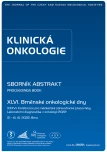Targeted RNA sequencing-based fusion gene analysis as a tool for diagnostics and therapeutic planning in pediatric cancer patients with solid tumors
Authors:
P. Pokorná 1; D. Al Tukmachi 1; K. Trachtová 1; H. Pálová 1; S. Adamcová 1; K. Koželková 1; P. Múdrý 2; Z. Pavelka 2; J. Štěrba 2; O. Slabý 1,3
Authors‘ workplace:
CEITEC – Středoevropský technologický institut, MU Brno
1; Klinika dětské onkologie LF MU a FN Brno
2; Biologický ústav, LF MU Brno
3
Published in:
Klin Onkol 2022; 35(Supplementum 1): 142-144
Category:
Article
Overview
Background: Pediatric cancer genome significantly differs from the genome of adult malignancies and is characterized by low tumor mutational burden, the great importance of epigenetic changes, and also the frequent occurrence of fusion genes. Fusion genes arise as a result of several types of chromosomal rearrangements, such as translocations, deletions, insertions, or inversions, and can have a variety of functional impacts. In the past, they were studied mainly in the context of hematological malignancies; however, their importance in the diagnostics and therapy of solid tumors is increasing. Materials and methods: In 250 patients with solid tumors from the Department of Pediatric Oncology of University Hospital Brno, an analysis of fusion genes was performed using targeted RNA sequencing. Sequencing libraries were prepared using the TruSight RNA Pan-Cancer Panel (Illumina), which covers 1 385 clinically relevant genes, and sequenced using the NextSeq Mid Output Kit (150 cycles) on the NextSeq 500 platform (Illumina). Sequencing reads were mapped to hg38 using the STAR aligner with parameters set to allow fusion genes detection. Arriba and STARfusion tools were used to search for fusion genes, which were subsequently manually verified in the IGV software. Results: Clinically relevant fusion genes were identified in 25% of patients. The largest proportion of fusions identified were fusions associated with sarcomas, such as EWSR1-FLI1, PAX3-FOXO1, or SS18-SSX1/ 2. The second-largest group was represented by CNS tumor fusions, especially KIAA1549-BRAF or other Ras/ MAPK-associated fusions. A previously undescribed DVL3-TFE3 fusion was identified in a renal carcinoma patient. 33% of the identified fusion genes were therapeutically targetable, and 2/ 3 of patients received corresponding treatment. Conclusion: The analysis of fusion genes is of great benefit in the diagnostics, prognostic stratification, and therapeutic planning of pediatric cancer patients. The use of high-throughput approaches such as RNA sequencing enables the identification of novel fusion genes as well as a deeper understanding of the complex changes that are involved in the development of the disease.
Keywords:
precision medicine – Next-generation sequencing – Pediatric oncology – gene fusion
Sources
1. Sweet-Cordero EA, Biegel JA. The genomic landscape of pediatric cancers: Implications for diagnosis and treatment. Science 2019; 363(6432): 1170–1175. doi: 10.1126/ science.aaw3535.
2. Mertens F, Johansson B, Fioretos T et al. The emerging complexity of gene fusions in cancer. Nat Rev Cancer 2015; 15(6): 371–381. doi: 10.1038/ nrc3947.
3. Rowley JD. Letter: A new consistent chromosomal abnormality in chronic myelogenous leukaemia identified by quinacrine fluorescence and Giemsa staining. Nature 1973; 243(5405): 290–293. doi: 10.1038/ 24329 0a0.
4. Seidal T, Mark J, Hagmar B et al. Alveolar rhabdomyosarcoma: a cytogenetic and correlated cytological and histological study. Acta Pathol Microbiol Immunol Scand [A] 1982; 90(5): 345–354. doi: 10.1111/ j.1699-0463.1982.tb00105_90a.x.
5. Dobin A, Davis CA, Schlesinger F et al. STAR: ultrafast universal RNA-seq aligner. Bioinformatics 2013; 29(1): 15–21. doi: 10.1093/ bioinformatics/ bts635.
6. Okonechnikov K, Conesa A, García-Alcalde F. Qualimap 2: advanced multi-sample quality control for high-throughput sequencing data. Bioinformatics 2016; 32(2): 292–294. doi: 10.1093/ bioinformatics/ btv566.
7. Picard Tools – by Broad Institute. [online]. Available from: https:/ / broadinstitute.github.io/ picard/ .
8. Uhrig S, Ellermann J, Walther T et al. Accurate and efficient detection of gene fusions from RNA sequencing data. Genome Res 2021; 31(3): 448–60. doi: 10.1101/ gr.257 246.119.
9. Haas BJ, Dobin A, Stransky N et al. STAR-fusion: fast and accurate fusion transcript detection from RNA-Seq. [online]. Available from: https:/ / www.biorxiv.org/ content/ 10.1101/ 120295v1.
10. Robinson JT, Thorvaldsdóttir H, Winckler W et al. Integrative genomics viewer. Nat Biotechnol 2011; 29(1): 24–26. doi: 10.1038/ nbt.1754.
11. Malgulwar PB, Nambirajan A, Pathak P et al. C11orf95-RELA fusions and upregulated NF-KB signalling characterise a subset of aggressive supratentorial ependymomas that express L1CAM and nestin. J Neurooncol 2018; 138(1): 29–39. doi: 10.1007/ s11060-018-2767-y.
12. Louis DN, Perry A, Wesseling P et al. The 2021 WHO classification of tumors of the central nervous system: a summary. Neuro-Oncol 2021; 23(8): 1231–1251. doi: 10.1093/ neuonc/ noab106.
13. Sbaraglia M, Bellan E, Dei Tos AP. The 2020 WHO classification of soft tissue tumours: news and perspectives. Pathologica 2021; 113(2): 70–84. doi: 10.32074/ 1591-951X-213.
14. Drilon A, Laetsch TW, Kummar S et al. Efficacy of larotrectinib in TRK fusion-positive cancers in adults and children. N Engl J Med 2018; 378(8): 731–739. doi: 10.1056/ NEJMoa1714448.
15. Argani P, Zhong M, Reuter VE et al. TFE3-fusion variant analysis defines specific clinicopathologic associations among Xp11 translocation cancers. Am J Surg Pathol 2016; 40(6): 723–737. doi: 10.1097/ PAS.0000000000000 631.
16. Yin X, Wang B, Gan W et al. TFE3 fusions escape from controlling of mTOR signaling pathway and accumulate in the nucleus promoting genes expression in Xp11.2 translocation renal cell carcinomas. J Exp Clin Cancer Res CR 2019; 38(1): 119. doi: 10.1186/ s13046-019-1101-7.
Labels
Paediatric clinical oncology Surgery Clinical oncologyArticle was published in
Clinical Oncology

2022 Issue Supplementum 1
- Metamizole vs. Tramadol in Postoperative Analgesia
- Metamizole in the Treatment of Acute Postoperative Pain
- Metamizole at a Glance and in Practice – Effective Non-Opioid Analgesic for All Ages
- Possibilities of Using Metamizole in the Treatment of Acute Primary Headaches
- Safety and Tolerance of Metamizole in Postoperative Analgesia in Children
Most read in this issue
- VIII. Radioterapeutické metody a radiofarmaka
- IV. Follow-up, sledování onkologických pacientů
- XXVIII. Neuroendokrinní a endokrinní nádory
- XXII. Nádory slinivky, jater a žlučových cest
